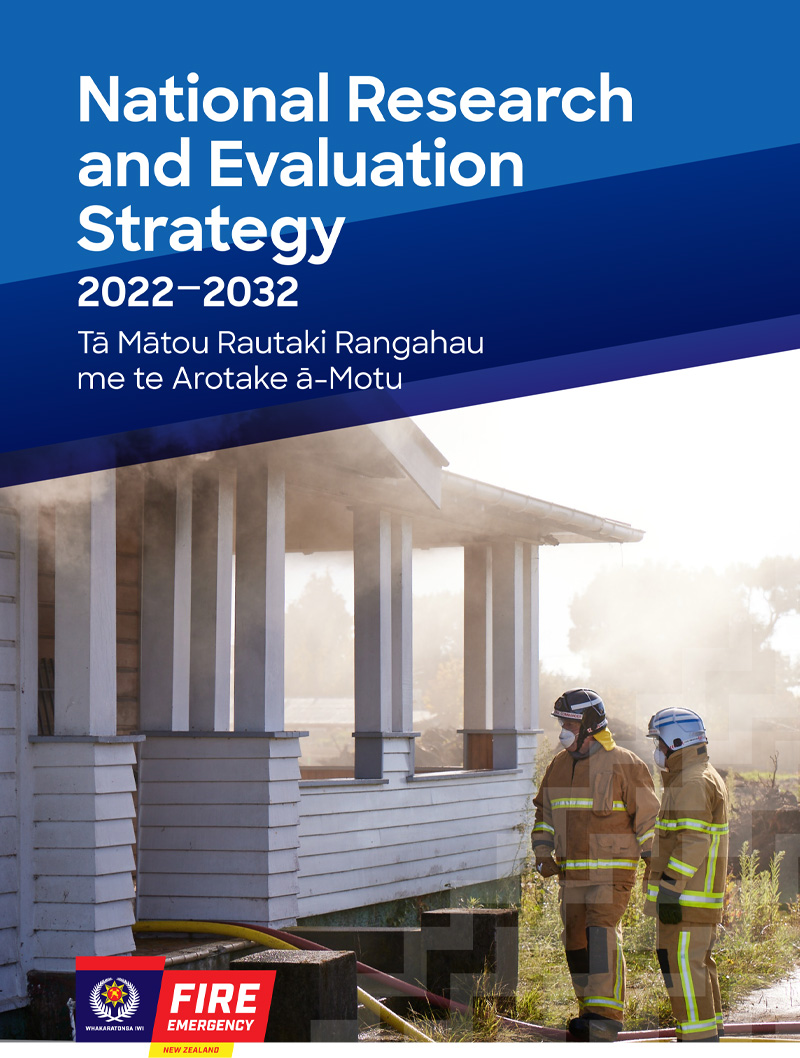In 2022, Fire and Emergency New Zealand published its first National Research and Evaluation Strategy 2022-2032.1 But what was the reason behind this and how does the strategy support the organisation?
Fire and Emergency New Zealand’s legislation highlights the importance of evidence-based services and we use research and evaluation (alongside other approaches) to uncover the evidence we need. This could be evidence on how we can increase the diversity of our workforce through to what works in terms of community recovery. At Fire and Emergency New Zealand, Te Ao Mārama is the team responsible for producing this evidence. This includes research, evaluation and library services.
The name, Te Ao Mārama, comes from a Māori term that is commonly delivered in oratory, ‘Ki te wheiao, ki te ao Mārama’. It has its genesis in the Māori creation story and refers to the transition from darkness into light; from a place of uncertainty to certainty.
In 2021, it was decided that Te Ao Mārama should lead the development of a national research and evaluation strategy so that Fire and Emergency New Zealand could have greater confidence that the evidence we produce feeds into organisational priorities. Ultimately, this is about getting greater impact and value from our investment in research and evaluation. This is more important than ever in a more financially constrained environment.

How the strategy supports the organisation
The strategy provides 2 clear outcomes. Firstly, it provides a set of principles for research and evaluation by which we can hold ourselves to account. Secondly, it gives a set of priority areas to focus our efforts on. We expand upon each of these below.
During the strategy development, we agreed on 3 guiding principles for this work, being useful, usable and used. They may sound familiar to you if you have seen the AFAC Research Strategy 2022-2027,2 but they were created independently of AFAC. But what do we mean by useful, usable and used?
Useful means that the research and evaluation we produce provides the right information at the right time for decision-makers. We need to ensure we’re asking the right questions, which means working closely with stakeholders and end users to understand the big decisions that are coming for the organisation. It also means that when we are scoping a research or evaluation project, our focus is on the business problems or decisions being made before we consider what the research and evaluation questions are.
Usable means that we produce research and evaluation in a timely and accessible way. Fire and Emergency New Zealand uses plain English in its reports and different media to communicate the evidence in ways that work for end users. This includes using methods like sense-making sessions, storytelling, interactive slide decks and presentations to provide engaging and relevant outputs for the organisation.
Used means that a key measure of the success of research and evaluation investment is that outputs are used as part of the evidence base in decision-making. Fire and Emergency New Zealand is committed to evidence-based decision-making, which means both decision-makers and those involved in creating evidence have a role in ensuring this happens.
Having these principles has enabled Te Ao Mārama to hold ourselves to account. They have formed the basis of the impact reviews we complete with internal stakeholders following delivery of a project and to evaluate the services we provide. In addition to the 3 guiding principles, the strategy has enabled Fire and Emergency New Zealand to identify 5 priority areas for investment in terms of research and evaluation:
- Our people - people are the most important resource for our organisation. People are our biggest investment and it is our people who deliver outcomes for communities. Useful and usable insights help us plan for a sustainable, adaptable and responsive workforce that is safe and prepared in an increasingly complex operating environment.
- Our communities - we strive to make our decisions closer to the communities we serve in line with the organisation’s broader direction and for everyone to know what decisions they are accountable for. This helps our communities prepare for, respond to, and recover well from emergencies. Integrating research and evaluation insights with our community engagement processes allows us to support communities to become increasingly resilient by reducing their vulnerability to threats.
- Our risks - keeping pace with change means we must identify opportunities to help achieve our strategic priorities. We maintain awareness of current and emerging risks that could impact on our ability to provide valued and trusted services to communities. Research and evaluation provide evidence for the insight and foresight that underpins our awareness of future trends that are relevant to our success.
- Our commitments - we work with Māori as tangata whenua (people of the land), improving our environmental performance and creating a fairer workplace. Research and evaluation provide insights into how we can meet these commitments and carry out our responsibilities as a provider of emergency management functions and regulatory compliance responsibilities, openly and with integrity.
- Our organisation - responsiveness to communities is integral to our ability to protect and preserve lives, property and the environment in a changing operating environment. Evidence and insights from research and evaluation, combined with incident data and community feedback, informs how we adapt our capability so that our services are trusted and valued, now and in the future.
The strategy has provided the Te Ao Mārama team with a useful lens through which to view its work and focus its efforts.


